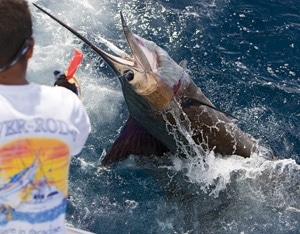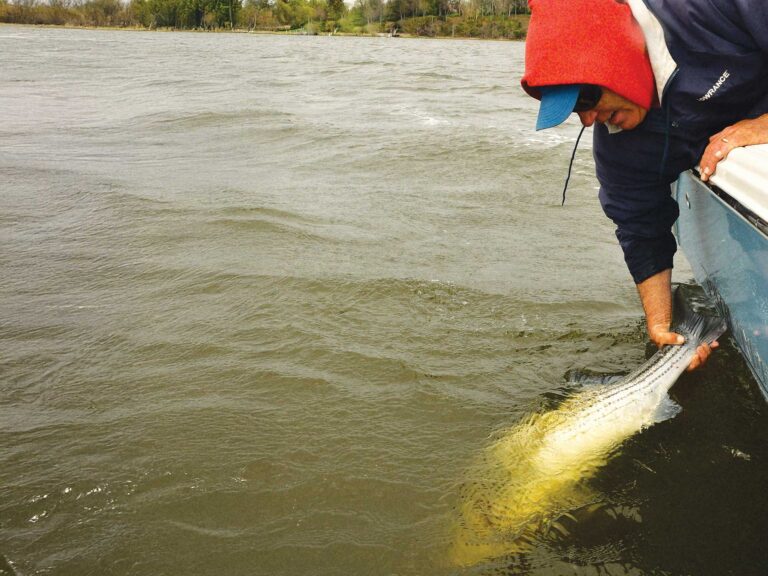
Loosely defined, evolution is the process of gradual change. From an angling standpoint, evolution begins with the very first tug on your line. That first fish is awesome, but after a few small catches, you gradually begin to change. The excitement of catching small fish dissipates, and the urge to do battle with larger fish begins to emerge. So what happens when you have caught your fill of big fish with standard tackle and you still want more? You, my friend, have evolved into a light-tackle angler. As the saying goes, big fish don’t get that way by being stupid, so you need to have a few tricks up your sleeve in this arena.
The masters of light tackle approach this specialized game with strategies and tactics honed through experience. Here’s a handful of tips from four of the best, three accomplished anglers and one renowned captain, that are guaranteed to supercharge your evolutionary process.
Lots of Shots
**

Capt. Skip Smith** has fished around the globe and is universally recognized as a pioneer in light-tackle fishing. Smith, considered the forefather of many techniques that have become standard practice, developed his approach through trial and error, and he believes the same process is an essential part of light-tackle skill development for any angler or captain.
On a typical light-tackle day, he’ll rig numerous outfits with everything from 2-pound to 12-pound line. With a full array of tackle at the ready when a fish storms the spread, the angler can choose the outfit best suited to the species, conditions and particular fish.
Smith says that getting the hook to set is not as tricky as you might think – especially when using circle hooks with baits that are properly rigged. With circle hooks, Smith uses a bridle that is twice as long as a standard bridle. This puts the hook about an inch above the bait instead of sitting snug against the bait (like a traditional bridle). Then the hook is free and can find a place to stick, without the bait getting in the way. “IGFA rules allow you to fish a 15-foot leader, and once the fish feels the leader going down its lateral line, it frantically kicks, and more often than not, the fish kicking the leader will set the hook for you,” says Smith. From that point on, as long as you keep the line halfway tight, you have a decent chance at catching the fish.
“The best advice that I can give is to go places that are notorious for big numbers of fish,” says Smith. “When you have days that provide numerous shots, you can try a fish on 12-pound line and then work your way down. When opportunity presents itself over and over, even a novice angler will be surprised at how quickly and consistently big pelagics can be taken on 8-pound line.”
Balanced Rig

Like Smith, Gary Carter has fished around the world and has the light-tackle accomplishments to show for his efforts and expertise.
Critical to success and often overlooked are hook and bait selection, Carter feels. When choosing a bait to fish on light line, you cannot choose a bait so big that it will break your line when it’s deployed. For example, a big bait like a bonito will snap 2-pound-test. The bait must be matched to the tackle. When you choose hooks, look for those that are constructed of the thinnest possible wire. A thinner-gauge hook penetrates much easier and with less pressure than heavier-wire hooks. The trick is to find a balance, a hook that is thin enough to penetrate with minimal pressure but strong enough not to straighten when the fish is boat-side.
When it comes to the fight, Carter believes that your drag plays the most important role of all. Light line doesn’t give you the luxury of putting the screws to a fish – ever. It’s really about finesse. With light line, you constantly have to make adjustments. For example, on the bite, you have to be somewhat aggressive with the drag to get the hook to penetrate and then be ready to quickly drop back into free-spool, or close to it, when the fish runs. When the fish comes near the boat, it’s time to carefully crank the drag back up and be more aggressive again. Carter says the quickest way to adjust your drag is simply to use your fingers on the spool: “You’d be surprised at how much drag you can apply by lightly touching the spool, and when the fish takes off, all you have to do is keep the reel from backlashing and let it run.”
Get Mean Fast
**

Pam Basco** is no stranger to long battles with mean fish. Her most memorable catch came in Kona, Hawaii, when she broke the yellowfin tuna record by besting a 157-pound fish on 20-pound line. For Basco that was not enough. Two days later, she shattered her own record with a 203½-pound yellowfin on 20-pound line. She is definitive when it comes to the most important element of fishing for big fish on light line: “You have to have a good captain and crew because it’s 100 percent a team effort,” she says. She highly recommends sticking with the same captain and crew each season so the essential ability to work as team develops. Otherwise, you have to learn the plays each time you get on a boat.

Basco also believes that knowing your tackle is key. “Test as many different rods, reels, harnesses, lines and hooks as you can, and assemble the setup that best fits you,” she says.
As to her fight strategy, Basco uses an aggressive approach in the early stages of the fight. When you are fishing light tackle, you are going to lose a lot of fish, plain and simple. Basco thinks it is better to put the heat on them in the beginning, when the drag has not been stressed and the line is fresh.
She says the most critical time is when a fish is close to the boat. That’s when you have the most acute angle on the fish and a short amount of line, which is far less forgiving than a longer line. At this point a lot can go wrong. Something she says many anglers don’t consider are the sea swells. When the fish is nearly straight up and down, a sudden swell can easily result in a breakoff if you don’t anticipate it.
Try, Try Again

Whether you seek IGFA records or would simply like to catch a big bonefish on extra-light tackle, Islamorada, Florida, is without a doubt one of the best places to do it. And Mark Cockerham, known in the upper Keys as the bonefish guru, is the expert to advise you. Cockerham typically finds big fish during falling tides on flats that slowly drop off into deep water. Ideally, he will spot the fish and have time to study them and determine their “mood.” The mood of the fish dictates how he develops his strategy. Once you’ve located the big fish and have enticed one to eat, the light-tackle game really begins. “Fishing IGFA 2-pound is insane – before I landed my first bonefish on 2-pound, I was probably one or two breakoffs away from giving up completely,” says Cockerham. “Your line can touch something as nonthreatening as a blade of turtle grass on the surface, and that will be enough to end the game.”

If you are up for the challenge, Cockerham strongly recommends building a tapered leader with short sections of mono. Start by making a Bimini loop with your 2-pound running line, then build a reverse-taper leader using bloods knots to add short sections of 6-, 8-, 10- and, finally, 12-pound mono. “The most important thing to remember when constructing your leader this way is to never completely cinch the blood knot that’s connecting the 2-pound and 6-pound – let the fish cinch that one for you,” he says. “Most of the time if you try to cinch that knot, it’s going to break – if you are lucky and manage to cinch it successfully, the knot has been stressed enough that it will break every time when a fish makes its initial run.” When fishing extremely light line, Cockerham prefers rods that are overly soft – something that allows for smooth lob casts. “Any jolt whatsoever in the cast will easily break 2-pound,” he says.
Another of Cockerham’s secrets is to use an extremely light wire, chemically sharpened Kahle hook, much like a bass hook. We already learned from Gary Carter that light wire penetrates with minimal force, but the real secret is the wider gap of the Kahle-style hook. This gap increases the odds of the hook finding a place to stick. “When the fish eats, there is absolutely no setting the hook – let it run, hope the hook sticks and make sure your guide is poling like hell,” says Cockerham. “Also, keep your rod tip as high as possible because big bones (especially those in Islamorada) will bury their noses into the bottom to try and break the leader or free the hook.”









